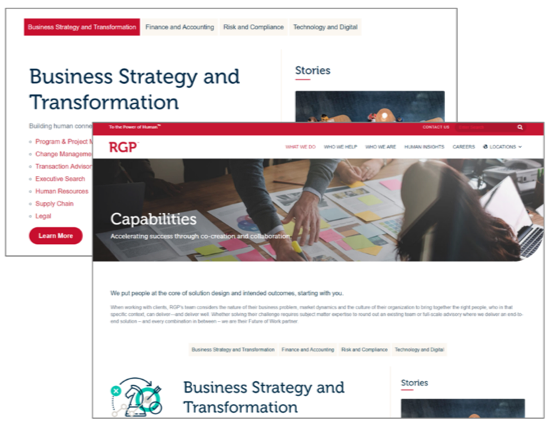RGP is a multinational firm that helps clients secure the right talent to help them more effectively tackle their key initiatives. RGP was founded in 1996 to support finance leaders manage their operational needs using a workforce model that disrupted the professional services industry. Today, RGP remains well positioned for the new ecosystem of work by still being able to provide the right resources for the work at hand, while maintaining respect for value, efficiency, and ease of use.
The Challenge
RGP suffered from the inability to consistently name and describe their solution offerings across the organization. This was displayed on their public website and was used by internal business units to communicate and present offerings to clients. This caused confusion during internal and external conversations. RGP realized the need for consistent solution-related terminology and a standard way to categorize and tag solutions content on their internal and external-facing platforms.
The Solution

RGP embarked on a journey to design a solutions-oriented business taxonomy for initial implementation on their redesigned RGP website. They began by forming a cross-functional team and partnering with EK. The taxonomy effort focused on addressing content needs for both internal and external audiences, including RGP employees, partners, and clients. To confirm the completeness and intuitiveness of the taxonomy, the team conducted various validation activities leveraging specific methodologies that blended well with RGP’s culture and maximized organizational response.
The team was also able to include candidates and clients to test the overall effectiveness of the taxonomy across the widest audience possible. To support managing the proposed taxonomy design over time, the taxonomy team developed and implemented a taxonomy governance plan and a content migration plan.
The EK Difference
Our EK team collaborated with RGP to design the solutions-oriented taxonomy. We leveraged our own hybrid methodology, consisting of a combination of top-down (human-driven, facilitated workshops, focus groups and interviews) and bottom-up (content-driven research and analysis) to drive the process. EK developed a starter taxonomy design that included a description of each attribute and a listing of the recommended taxonomy of terms for each, with the solutions taxonomy being the primary taxonomy focus.
To ensure that the taxonomy could accommodate both searching and browsing, EK performed three complementary methods of testing and validation: corpus analysis, tree test, and test tagging. These validation methods test the alignment, usability, and completeness of the taxonomy.

One of the challenges that the organization experienced was the multiple perspectives on how solutions content should be organized and tagged, depending on the nature and purpose of the content. EK led strategic discussions with key stakeholders representing various business areas in order to represent and take into consideration those multiple perspectives (i.e., Marketing, Sales, and Financial Reporting teams). This approach carried over into the Taxonomy Governance Model and the Content Migration Plan that EK proposed for RGP to ensure that decisions about taxonomy changes and enhancements took into consideration multiple perspectives within the organization.
The Results
In June 2019, RGP implemented the solutions-oriented taxonomy in the public website (RGP.com), in addition to several internal systems (e.g., Salesforce). The result was a highly intuitive design that reflects the vocabulary of RGP employees and client end-users, which made solutions content easily findable across the organization. In the first quarter since launch, leads stemming from the website featuring the newly-designed taxonomy have contributed to six figures in closed revenue.
The process of developing and running the taxonomy has had an impact on how RGP does business internally as well. The monthly Taxonomy Governance meetings are being heralded across the organization as the example of how other meetings should be conducted. Adoption has been rapid with integration into key systems, giving the firm an important first step toward clear communication and reporting. The organization is currently making plans to broaden their taxonomy into a true enterprise taxonomy. As our client stated, “this has been so rewarding. The business is getting value from it that can be appreciated every day.”
